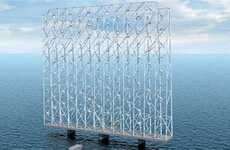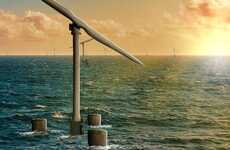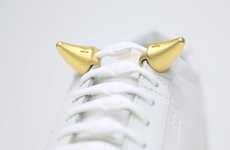
This Wind Turbine Uses Flapping Wing Motions to Create Electricity
Rahul Kalvapalle — April 7, 2014 — Eco
German automation technology company Festo developed the DualWingGenerator, a wind turbine that uses a flapping wing motion to convert power into electricity.
The DualWingGenerator wind turbine consists of a vertical column and two pairs of wings that measure 2.5 meters across. The wings are fitted to sliders and move up and down as air flows across their surface. As the wind blows, the two pairs of wings move in opposite directions. The kinetic force they generate is transferred to an electricity generator to be converted to electricity.
While this wind turbine's output is related to the strength of the wind, Festo intends to use intelligent control technology to lessen its dependence on wind. This technology will enable the system to optimize its operations and adapt to different wind conditions to get the most out of them.
The DualWingGenerator is not yet market-ready, but Festo believes it can eventually be used to generate electricity in buildings.
The DualWingGenerator wind turbine consists of a vertical column and two pairs of wings that measure 2.5 meters across. The wings are fitted to sliders and move up and down as air flows across their surface. As the wind blows, the two pairs of wings move in opposite directions. The kinetic force they generate is transferred to an electricity generator to be converted to electricity.
While this wind turbine's output is related to the strength of the wind, Festo intends to use intelligent control technology to lessen its dependence on wind. This technology will enable the system to optimize its operations and adapt to different wind conditions to get the most out of them.
The DualWingGenerator is not yet market-ready, but Festo believes it can eventually be used to generate electricity in buildings.
Trend Themes
1. Flapping Wing Energy Generation - Using flapping wing motions to generate electricity presents a disruptive innovation opportunity in the renewable energy sector.
2. Intelligent Control Technology - The use of intelligent control technology in wind turbines can optimize operations and adapt to different wind conditions, creating a disruptive innovation opportunity in the energy industry.
3. Building-integrated Wind Turbines - The potential use of wind turbines like the DualWingGenerator to generate electricity in buildings opens up a disruptive innovation opportunity in the construction and renewable energy industries.
Industry Implications
1. Renewable Energy - The flapping wing energy generation trend presents opportunities for disruptive innovation in the renewable energy industry.
2. Energy - The adoption of intelligent control technology in wind turbines creates a disruptive innovation opportunity in the energy industry.
3. Construction - The incorporation of building-integrated wind turbines opens up a disruptive innovation opportunity in the construction industry.
6.1
Score
Popularity
Activity
Freshness























